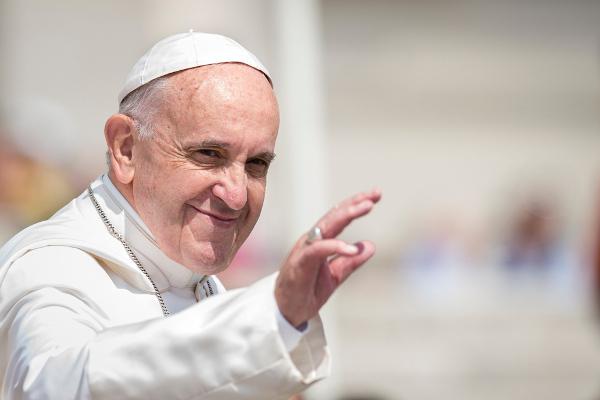O Pope Bento XVI he was the 265th pope of the Roman Catholic Church. Originally called Joseph Aloisius Ratzinger, he was born on April 16, 1927, in Marktl, Germany. In the pontificate, he stayed from April 24, 2005 until February 28, 2013, when he resigned.
Pope Benedict XVI died on the morning of December 31, 2022, at the age of 95, in the monastery where he had lived since his retirement, in the Vatican.
Read too: Alexander VI, the corrupt pope
Topics of this article
- 1 - Origins of Benedict XVI
- 2 - Beginning of the priestly life of Benedict XVI
- 3 - Years of Benedict XVI as pope
- 4 - Resignation of Benedict XVI
- 5 - Death of Benedict XVI
Origins of Benedict XVI
Joseph Ratzinger is the son of the Commissioner of Police also called Joseph Ratzinger and Maria Ratzinger, who before marriage worked as a cook. the pope was the youngest of two brothers elders, Georg and Maria.
The pope grew up in the town of Traunstein, close to the border with Austria. At the age of 12, Joseph had his first experience with the Church, when he took the seminar, which was one of the first steps within the religion.
At the age of 16, in 1943, during the Second World War, Joseph served Germany in an anti-aircraft battery.
Do not stop now... There's more after the publicity ;)
Beginning of the priestly life of Benedict XVI
After his service in World War II, Joseph and his brother continued their studies at the Church's seminary in Freising. On June 29, 1951, Joseph was ordained a priest.
Soon after, he began teaching at the Higher School of Freising. Continuing his studies within religion, in 1953 he graduated with a Doctor of Theology. His thesis was People and House of God in the doctrine of the Church of Saint Augustine.
In the following years, he continued his career of studies and teaching within the Church. In 1957, he did Habilitation with Professor of Theology Gottlieb Söhngen, with a paper on Bonaventure's Theology of History.
After that he worked in Bonn (1959-1969), in Münster (1963-1966) and in Tübingen (1966-1969). The priest took over as professor of Dogmatics and the History of Dogmas at the University of Regensburg in 1969.
joseph continued with publications and studies of theology during the following decades, especially in 1973, when he published the volume Dogma and Revelation, which brings together essays, meditations and homilies dedicated to pastoral care. At Catholic church, pastoral are the activities developed, organized and directed by dioceses and parishes. The pastorals aim to respond to specific situations of religion. The term is linked to the figure of pastor and evangelization.
His dedication to the Church was recognized when, in 1977 Pope Paul VI appointed him Archbishop of Münster and Freising. Years later, in 1981, Pope John Paul II appointed him prefect of the Congregation for the Doctrine of the Faith.
The priest was also president of the Pontifical Biblical Commission and the International Theological Commission. On February 15, 1982, he resigned from the pastoral government of the Archdiocese of Münster and Freising.
In 1991, the cardinal had a stroke that affected his eye. left. Then, in 1994, an embolism caused the total loss of vision in that eye.
Already in the 2000s, still as prefect of the Congregation for the Doctrine of the Faith, the then bishop approved the document Memory and Reconciliation: The Church and the faults of the past, of the International Theological Commission, which accompanied Pope John Paul II's request for pardon in the Jubilee.
That year, he also became an honorary member of the Vatican Academy of Sciences. In 2002, he was elected dean by the pope. The dean is the president of the College of Cardinals and who convenes and presides over the conclave that elects the new pope.
Read too: Mother Teresa of Calcutta — one of the most important personalities of Catholicism
Benedict XVI's years as pope
After the death of Pope John Paul II, in 2005, the cardinal was elected the new pope of the Church. Thus, from April 19, 2005, he assumed the name of Benedict XVI.
Early in his pontificate, he emphasized the pope's mission as pastor of the Catholic Church and fisherman of men. Also in 2005, he went to Germany, where he held a Mass for a million people during the 20th World Youth Day.
The following year, he traveled to Poland, where visited the concentration camp from Auschwitz. The pope prayed in front of 22 tombstones honoring the victims of Nazi Germany.
In 2007, Brazil was the destination of the new pope. On his first visit to the country as pope, Benedict XVI participated in the 5th General Conference of the Latin American and Caribbean Episcopate (CELAM).
Still in Brazil, the pope canonized the first saint born in Brazil, Santo Antônio de Sant'Anna Galvão, the Friar Galvao.
In 2011, Joseph performed the beatification ceremony for his predecessor, Pope John Paul II. The following year, Benedict XVI opened an official Twitter account, where he posted reflections of the angelus Sunday.
Resignation of Benedict XVI
Benedict XVI resigned as pope on February 11, 2013. The pope was the first of his rank to resign from office in 600 years of the Catholic Church.
After his resignation, Benedict XVI lived in seclusion in the Vatican. His successor, Pope Francis, was elected on March 19, 2013.

Despite the seclusion, the pope emeritus published a book in 2021, called true europe, in which he criticizes same-sex marriage.
Death of Benedict XVI
Already in poor health, the pope emeritus died at age 95, on December 31, 2022. Benedict XVI's wake was held in St. Peter's Square, in the Vatican, with a funeral mass celebrated by Pope Francis.
image credits
[1] vipflash / Shutterstock
[2] AM113 / Shutterstock
By Miguel Souza
Journalist
Click through to learn the story of Alexander VI and how he used his position to increase his family's influence.
This Sunday, supporters of the former President of the Republic, Jair Bolsonaro, invaded the National Congress, the Supreme Court and the Planalto Palace, in an act of terrorism.
The trajectory and values preached by the largest Christian religion in the world.
See the history of the Catholic Church from persecution, freedom and officialdom of worship in Rome to the creation of the Vatican State in the 20th century.
She learns about the life and accomplishments of Mother Teresa of Calcutta. Religious who founded the Missionaries of Charity and dedicated her life to helping those in need.
Learn about Spanish mystical saints and what they meant to modern times.



